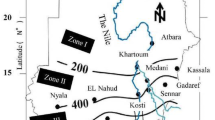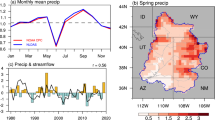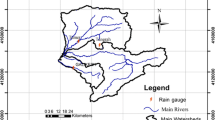Abstract
Summer rainfall (June–September) accounts for about 80% of the annual rainfall in the Lake Tana basin of Ethiopia, the source region of the Blue Nile River. Prediction of summer rainfall would be valuable for managing the region’s water resources and agricultural operations. This study investigated the influence of sea surface temperature (SST) as a predictor of summer rainfall in the basin by applying cross-correlation analysis between summer rainfall and climatic indices and SST in various oceanic regions from 1985 to 2015. Summer rainfall showed a strong negative correlation (− 0.619) with the Pacific Decadal Oscillation index at short time lags. Further analysis identified strong teleconnections (|r| ≥ 0.5) between SSTs in specific parts of the Pacific Ocean and summer rainfall in the Lake Tana basin, raising the possibility of predicting summer rainfall from Pacific SSTs with a lead time of 4 to 5 months. Average SSTs of an area near the Philippines and an area west of North America were positively correlated (0.629) and negatively correlated (− 0.538), respectively, with summer rainfall in the Lake Tana basin. Predictions of summer rainfall from these teleconnected SSTs by an Elman recurrent neural network model were encouraging, indicating a strong correlation (r > 0.77) between the observed and predicted summer rainfall. Our results suggest that neural network techniques may have sufficient skill to support seasonal rainfall predictions over the Lake Tana basin.










Similar content being viewed by others
References
Abtew W, Melesse AM, Dessalegne T (2009) El Niño southern oscillation link to the Blue Nile River basin hydrology. Hydrol Process 23:3653–3660. https://doi.org/10.1002/hyp.7367
Amarasekera K, Lee R, Williams E, Eltahir E (1997) ENSO and the natural variability in the flow of tropical rivers. J Hydrol 200(1–4):24–39. https://doi.org/10.1016/S0022-1694(96)03340-9
Barnes J (2017) The future of the Nile: climate change, land use, infrastructure management, and treaty negotiations in a transboundary river basin. WIREs Clim Change e449. DOI https://doi.org/10.1002/wcc.449
Berhane F, Zaitchik B, Dezfuli A (2014) Subseasonal analysis of precipitation variability in the Blue Nile River basin. J Clim 27(1):325–344. https://doi.org/10.1175/JCLI-D-13-00094.1
Bishop CM (1995) Neural networks for pattern recognition. Oxford University Press, New York
Brown DP, Comrie AC (2004) A winter precipitation “dipole” in the western United States associated with multi-decadal ENSO variability. Geophys Res Lett 31:L09203. https://doi.org/10.1029/2003GL018726
Camberlin P (1995) June–September rainfall in north-eastern Africa and atmospheric signals over the tropics: a zonal perspective. Int J Climatol 15:773–783
Camberlin P (1997) Rainfall anomalies in the source region of the Nile and their connection with the Indian summer monsoon. J Clim 10(6):1380–1392. https://doi.org/10.1175/1520-0442(1997)010<1380:RAITSR>2.0.CO;2
Camberlin P, Fontaine B, Louvet S, Oettli P, Valimba P (2010) Climate adjustments over Africa accompanying the Indian monsoon onset. J Clim 23:2047–2064. https://doi.org/10.1175/2009JCLI3302.1
Cho V (2003) A comparison of three different approaches to tourist arrival forecasting. Tour Manag 24(2003):323–330
Conway D (2000) The climate and hydrology of the Upper Blue Nile River. Geogr J 166(1):49–62
Dash NB, Panda SN, Remesan R, Sahoo N (2010) Hybrid neural modeling for groundwater level prediction. Neural Compt Appl 19(8):1251–1263. https://doi.org/10.1007/s00521-010-0360-1
Deser C, Phillips AS, Alexander MA (2010) Twentieth century tropical sea surface temperatures trends revisited. Geophys Res Lett 37:L10701
Dinku T, Funk C, Peterson P, Maidment R, Tadesse T, Gadain H, Ceccato P (2018) Validation of CHIRPS satellite rainfall estimates over eastern of Africa. Q J Royal Meteorol Soc 144:292–312. https://doi.org/10.1002/qj.3244
Diro GT, Grimes DIF, Black E (2011a) Teleconnections between Ethiopian summer rainfall and sea surface temperature: part I. Observation and modeling. Clim Dyn 37(1):121–131. https://doi.org/10.1007/s00382-010-0837-8
Diro GT, Grimes DIF, Black E (2011b) Teleconnections between Ethiopian summer rainfall and sea surface temperature: part II. Seasonal forecasting. Clim Dyn 37(1):121–131. https://doi.org/10.1007/s00382-010-0896-x
Ebabu K, Tsunekawa A, Haregeweyn N, Adgo E, Meshesha DT, Aklog D, Masunaga T, Tsubo M, Sultan D, Fenta AA, Yibeltal M (2018) Analyzing the variability of sediment yield: a case study from paired watersheds in the Upper Blue Nile basin, Ethiopia. Geomorphology 303:446–455. https://doi.org/10.1016/j.geomorph.2017.12.020
Elman JL (1990) Finding structure in time. Cogn Sci 14:179–121
Elsanabary MH, Gan TY (2014) Wavelet analysis of seasonal rainfall variability of the Upper Blue Nile Basin, its teleconnection to global sea surface temperature, and its forecasting by an artificial neural network. Mon Weather Rev 142(5):1771–1791. https://doi.org/10.1175/MWR-D-13-00085.1
Fenta AA, Rientjes T, Haile TH, Reggiani P (2014) Satellite rainfall products and their reliability in the Blue Nile Basin. In: Mesele A, Abtew W, Setegn S (eds) Nile River Basin: Ecohydrological Challenges, Climate Change and Hydropolitics. Springer-Verlag, pp. 51–67. https://doi.org/10.1007/978-3-319-02720-3_4
Fenta AA, Yasuda H, Shimizu K, Haregeweyn N, Negussie A (2016) Dynamics of soil erosion as influenced by watershed management practices: a case study of the agula watershed in the semi-arid highlands of northern Ethiopia. Environ Manag 58:889–905. https://doi.org/10.1007/s00267-016-0757-407
Fenta AA, Yasuda H, Shimizu K, Haregeweyn N (2017a) Response of streamflow to climate variability and changes in human activities in the semi-arid highlands of northern Ethiopia. Reg Environ Chang 17:1229–1240. https://doi.org/10.1007/s10113-017-1103-y
Fenta AA, Yasuda H, Shimizu K, Haregeweyn N, Kawai T, Sultan D, Ebabu K, Belay AS (2017b) Spatial distribution and temporal trends of rainfall and erosivity in the Eastern Africa region. Hydrol Process 31:4555–4567. https://doi.org/10.1002/hyp.11378
Fenta AA, Yasuda H, Shimizu K, Ibaraki Y, Haregeweyn N, Kawai T, Belay AS, Sultan D, Ebabu K (2018) Evaluation of satellite rainfall estimates over the Lake Tana basin at the source region of the Blue Nile River. Atmos Res 212:43–53. https://doi.org/10.1016/j.atmosres.2018.05.009
Folland C, Palmer T, Parker D (1986) Sahel rainfall and worldwide sea temperatures 1901–1985. Nature 320:602–607
Funk C, Peterson P, Landsfeld M et al (2015) The climate hazards infrared precipitation with stations—a new environmental record for monitoring extremes. Sci Data 2:1–21. https://doi.org/10.1038/sdata.2015.66
Gebrehiwot T, van der Veen A, Maathuis B (2011) Spatial and temporal assessment of drought in the northern highlands of Ethiopia. Int J Appl Earth Obs Geoinf 13:309–321
Gebremedhin MA, Abraha AZ, Fenta AA (2017) Changes in future climate indices using statistical downscaling model in the upper Baro basin of Ethiopia. Theor Appl Climatol 133:39–46. https://doi.org/10.1007/s00704-017-2151-4
Gershunov A, Barnett TP (1998) Interdecadal modulation of ENSO teleconnections. Bull Am Meteorol Soc 79:2715–2725. https://doi.org/10.1175/1520-0477(1998)079,2715:IMOET.2.0.CO;2
Gissila T, Black E, Grimes DIF, Slingo JM (2004) Seasonal forecasting of the Ethiopian summer rains. Int J Climatol 24:1345–1358
Gleixner S, Keenlyside N, Viste E, Korecha D (2017a) The El Niño effect on Ethiopian summer rainfall. Clim Dyn 49(5–6):1865–1883. https://doi.org/10.1007/s00382-016-3421-z
Gleixner S, Keenlyside NS, Demissie TD, Counillon F, Wang Y, Viste E (2017b) Seasonal predictability of Kiremt rainfall in coupled general circulation models. Environ Res Lett 12:114016
Goyal MK, Ojha CSP (2012) Downscaling of surface temperature for lake catchment in an arid region in India using linear multiple regression and neural networks. Int J Climatol 32:552–566. https://doi.org/10.1002/joc.2286
Haregeweyn N, Tsunekawa A, Poesen J, Tsubo M, Meshesha DT, Fenta AA, Nyssen J, Adgo E (2017) Comprehensive assessment of soil erosion risk for better land use planning in river basins: case study of the Upper Blue Nile River. Sci Total Environ 574:95–108. https://doi.org/10.1016/j.scitotenv.2016.09.019
Hu ZZ, Huang B (2009) Interferential impact of ENSO and PDO on dry and wet conditions in the U.S. Great Plains J Clim 22:6047–6065. https://doi.org/10.1175/2009JCLI2798.1
Indeje M, Semazzi FH, Ogallo LJ (2000) ENSO signals in East African rainfall seasons. Int J Climatol 20:19–46
Jury MR (2010) Ethiopian decadal climate variability. Theor Appl Clim 101:29–40. https://doi.org/10.1007/s00704-009-0200-3
Kebede S, Travi Y, Alemayehu T, Marc V (2006) Water balance of Lake Tana and its sensitivity to fluctuations in rainfall, Blue Nile basin, Ethiopia. J Hydro 316:233–247. https://doi.org/10.1016/j.jhydrol.2005.05.011
Korecha D, Barnston AG (2007) Predictability of June–September rainfall in Ethiopia. Mon Wea Rev 135(2):628–650. https://doi.org/10.1175/MWR3304.1
Kumbuyo C, Yasuda H, Kitamura Y, Shimizu K (2014) Fluctuation of rainfall time series in Malawi: an analysis of selected areas. Geofizika 31:13–34. https://doi.org/10.15233/gfz.2014.31.1
Kurtzman D, Scanlon BR (2007) El Niño–Southern Oscillation and Pacific Decadal Oscillation impacts on precipitation in the southern and central United States: evaluation of spatial distribution and predictions. Water Resour Res 43:W10427. https://doi.org/10.1029/2007WR005863
Lin H, Brunet G, Derome J (2009) An observed connection between the North Atlantic oscillation and the Madden–Julian oscillation. J Clim 22(2):364–380. https://doi.org/10.1175/2008JCLI2515.1
Lloyd-Hughes B, Saunders MA (2002) Seasonal prediction of European spring precipitation from El Nino Southern Oscillation and local sea-surface temperatures. Int J Climatol 22(1):1–14. https://doi.org/10.1002/joc.723
Lyon B (2014) Seasonal drought in the Greater Horn of Africa and its recent increase during the March-May long rains. J Clim 27(21):7953–7975. https://doi.org/10.1175/JCLI-D-13-00459.1
Mantua NJ, Hare SR, Zhang Y, Wallace JM, Francis RC (1997) A Pacific interdecadal climate oscillation with impacts on salmon production. Bull Am Meteorol Soc 78:1069–1080
McCabe GJ, Ault TR, Cook BI, Betancourt JL, Schwartz MD (2012) Influences of the El Niño Southern Oscillation and the Pacific Decadal Oscillation on the timing of the North American spring. Int J Climatol 32:2301–2310. https://doi.org/10.1002/joc.3400
McCartney M, Alemayehu T, Shiferaw A, Awulachew SB (2010) Evaluation of current and future water resources development in the Lake Tana Basin, Ethiopia. Int Water Management Institute, Colombo, Sri Lanka 44 pp. ISBN 978-92-9090-721-3. https://doi.org/10.3910/2010.204
McHugh MJ, Rogers JC, McHugh MJ, Rogers JC (2001) North Atlantic oscillation influence on precipitation variability around the southeast African convergence zone. J Clim 14(17):3631–3642. https://doi.org/10.1175/1520-0442(2001)014<3631:NAOIOP>2.0.CO;2
Nicholson SE (2017) Climate and climatic variability of rainfall over eastern Africa. Rev Geophys 55(3):590–635. https://doi.org/10.1002/2016rg000544
Oakley NS, Redmond KT (2014) Aclimatology of 500 hPa closed lows in the northeastern Pacific Ocean, 1948–2011. J Appl Meteorol Climatol 53:1578–1592. https://doi.org/10.1175/JAMC-D-13-0223.1
Olsson J, Uvo CB, Jinno K (2001) Statistical atmospheric downscaling of short-term extreme rainfall by neural networks. Phys Chem Earth Pt B 26:695–700. https://doi.org/10.1016/S1464-1909(01)00071-5
Rayner N, Parker D, Horton E, et al (2003) Global analysis of sea surface temperature, sea ice and night marine air temperature since the late nineteenth century. J Geophys Res 108(d14):4407. https://doi.org/10.1029/2002JD002670
Rientjes T, Haile AT, Fenta AA (2013) Diurnal rainfall variability over the Upper Blue Nile Basin: A remote sensing based approach. Int J Appl Earth Obs Geoinf 21, 311–325. https://doi.org/10.1016/j.jag.2012.07.009
Saji NH, Goswami BN, Vinayachandran PN, Yamagata T (1999) A dipole mode in the tropical Indian Ocean. Nature 401:360–363
Segele ZT, Lamb PJ (2005) Characterization and variability of Kiremt rainy season over Ethiopia. Meteorog Atmos Phys 89:153–158
Segele ZT, Lamb PJ, Leslie LM (2009) Large-scale atmospheric circulation and global sea surface temperature associations with Horn of Africa June–September rainfall. Int J Climatol 29:1075–1100
Seleshi Y, Demaree GR (1995) Rainfall variability in the Ethiopian and Eritrean highlands and its links with the Southern Oscilation Index. J Biogeogr 22:945–952
Seleshi Y, Zanke U (2004) Recent changes in rainfall and rainy days in Ethiopia. J Climatol 24:973–983 https://doi.org/10.1002/joc.1052
Sfersos A, Coonick AH (2000) Univariate and multivariate forecasting of hourly solar radiation with artificial intelligence techniques. Sol Energy 68:169–178
Smith IN, McIntosh P, Ansell TJ, Reason CJC, McInnes K (2000) Southwest western Australian winter rainfall and its association with ocean climate variability. Int J Climatol 20:1913–1930. https://doi.org/10.1002/1097-0088(200012)20:15<1913::AID-JOC594>3.0.CO;2-J
Sultan D, Tsunekawa A, Haregeweyn N, Adgo E, Tsubo M, Meshesha DT, Masunaga T, Aklog D, Fenta AA, Ebabu K (2018a) Impact of soil and water conservation interventions on watershed runoff response in a tropical humid highland of Ethiopia. Environ Manag 61:860–874. https://doi.org/10.1007/s00267-018-1005-x
Sultan D, Tsunekawa A, Haregeweyn N, Adgo E, Tsubo M, Meshesha DT, Masunaga T, Aklog D, Fenta AA, Ebabu K (2018b) Efficiency of soil and water conservation practices in different agro-ecological environments of Ethiopia’s Upper Blue Nile basin. J Arid Land 10(2):249–263. https://doi.org/10.1007/s40333-018-0097-8
Taye MT, Willems P (2012) Temporal variability of hydroclimatic extremes in the Blue Nile basin. Water Resour Res 48(3):1–13. https://doi.org/10.1029/2011WR011466
Uvo CB, Repelli CA, Zebiak SE, Kushnir Y (1998) The relationships between tropical Pacific and Atlantic SST and northeast Brazil monthly precipitation. J Clim 11:551–562. https://doi.org/10.1175/15200442(1998)011<0551:TRBTPA>2.0.CO;2
Wang D, Wang C, Yang X, Lu J (2005) Winter Northern Hemisphere surface air temperature variability associated with the Arctic Oscillation and North Atlantic Oscillation. Geophys Res Lett 32(16):L16706. https://doi.org/10.1029/2005GL022952
Williams AP, Funk C, Michaelsen J, Rauscher SA, Robertson I, Wils THG, Koprowski M, Eshetu Z, Loader NJ (2012) Recent summer precipitation trends in the Greater Horn of Africa and the emerging role of Indian Ocean sea surface temperature. Clim Dyn 39:2307–2328. https://doi.org/10.1007/s00382-011-1222-y
Yasuda H, Berndtsson R, Saito T, Anyoji H, Zhang X (2009) Prediction of Chinese Loess Plateau summer rainfall using Pacific Ocean spring sea surface temperature. Hydrol Process 23:719–729. https://doi.org/10.1002/hyp.71722008.11
Yasuda H, Nandintsetseg B, Berndtsson R, Shinoda M, Kawai T (2017) The effects of ocean SST dipole differences on Mongolian summer rainfall. Geofizika 34:199–218. https://doi.org/10.15233/gfz.2017.34.10
Yasuda H, Panda SN, Abd Elbasit MAM, Kawai T, Elgamri T, Fenta AA, Nawata H (2018) Teleconnection of rainfall time series in the central Nile Basin with sea surface temperature. Paddy Water Environ (0123456789). doi https://doi.org/10.1007/s10333-018-0671-x
Yuan F, Yasuda H, Berndtsson R, Uvo CB, Zhang L, Hao Z, Wang XP (2016) Regional sea surface temperatures explain spatial and temporal variation of summer rainfall in the source region of the Yellow River. Hydrol Sci J 61:1383–1394. https://doi.org/10.1080/02626667.2015.1035658
Zhang X, Wang J, Zwiers FW, Groisman PY (2010) The influence of large-scale climate variability on winter maximum daily precipitation over North America. J Clim 23:2902–2915. https://doi.org/10.1175/2010JCLI3249.1
Acknowledgements
We thank the Ethiopian National Meteorological Agency for providing the rain gauge data. Our data sources consisted of CHIRPS satellite rainfall data (https://chg.geog.ucsb.edu/data/chirps/), the CRU database (https://www.cru.uea.ac.uk/data), and HadISST data from the British Atmospheric Data Center.
Funding
We thank the Egypt-Japan Education Partnership for the Ph.D. research grant for the first author. This study was financially supported by the International Platform for Dryland Research and Education, Tottori University.
Author information
Authors and Affiliations
Corresponding author
Additional information
Publisher’s note
Springer Nature remains neutral with regard to jurisdictional claims in published maps and institutional affiliations.
Rights and permissions
About this article
Cite this article
Alhamshry, A., Fenta, A.A., Yasuda, H. et al. Prediction of summer rainfall over the source region of the Blue Nile by using teleconnections based on sea surface temperatures. Theor Appl Climatol 137, 3077–3087 (2019). https://doi.org/10.1007/s00704-019-02796-x
Received:
Accepted:
Published:
Issue Date:
DOI: https://doi.org/10.1007/s00704-019-02796-x




